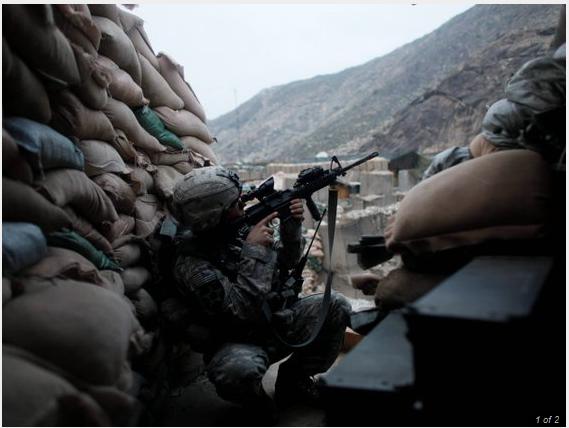From the Weekly Standard:
While we should be thankful that various individuals at Fort Hood acted in a “prompt and courageous” manner thereby preventing “greater losses,” it should never have gotten to that point. The Defense Department’s system is not working if it is left to first responders to stop a terrorist. A traitor within the military’s ranks, with compromised loyalties that had been known about for years—as was the case with Hasan—should be stopped before his finger is on the trigger.
Therein lies the central problem with the Pentagon’s report. It says nothing of consequence about Hasan or how to stop individuals like him in the future. Hasan is not even named in the report, but instead referred to as the “alleged perpetrator.” The report’s authors contend that the sanctity of the criminal investigation into the shooting needs to be upheld. But this is not an excuse for failing to name the attacker. The whole world knows that Major Nidal Malik Hasan did it.
Nor is the ongoing criminal investigation a valid reason for avoiding a serious discussion of Hasan’s ideological disposition. The report’s authors instead go to lengths to whitewash Hasan’s beliefs.
The report lumps all sorts of deviant and problematic behaviors together as if they have the same relevance to the events of November 5. Thus, we find a discussion of alcohol and drug abuse, sexual violence, elder abuse, and the disgusting methods employed by child molesters. We also learn of the deleterious effects of events “such as divorce, loss of a job, or death of a loved one,” all of which “may trigger suicide in those who are already vulnerable.”
Was Major Nidal Malik Hasan a child molester, a drug addict, or suicidal because of a recent divorce? No. So what does any of this have to do with the attack at Fort Hood? Absolutely nothing.
What is relevant is Hasan’s religious and political beliefs. He is a jihadist, although you would never know it by reading the Pentagon’s report. Instead in the report’s “literature review of risk factors for violence,” one comes across this sentence:
Religious fundamentalism alone is not a risk factor; most fundamentalist groups are not violent, and religious-based violence is not confined to members of fundamentalist groups.
This is a true statement; it is also completely meaningless in respect to the Fort Hood massacre. The brand of religious fundamentalism practiced by Hasan is specifically devoted to violence.
This article by Thomas Joscelyn rehearses some of the things we discussed in Radicalized Christian Terrorism. On a complex topic it’s easy to misunderstand truncated prose. This is the kind of topic that is better carried out as a series of conversations.
A number of readers / commenters conflated boundary conditions. This comment comes to us from Aristekrat:
I think it would certainly be fair to name any abortion bombing or killing as Christian terrorism. Admittedly, that is not near the problem that exists in Islam, but I disagree that is because Christianity is inherently peaceful and Islam is violent. At one time Christianity was not at all peaceful; surprisingly no one has mentioned the reformation and the wars of religion that lasted an extraordinarily long time, tore Europe apart, and were monstrously violent. That violence ultimately exhausted Europe and led to the Peace of Westphalia, the first harbinger of secularism. As secularism (and nationalism) ascended so religious violence in Europe dropped. Are you comfortable with the idea that the greater prevalence of religious violence in Islam might not be due to Islam being a more violent religion but because western civilization has embraced the (now) leftist doctrine of secularism and Islamic countries have not?
This is a very far reaching and broad comment and we will have to deal with aspects of it in later conversations. Suffice it to say that the proposition that secularism is related to a reduction in violence is incorrect from my vantage point, and the author of the comment is advised to study the following two texts:
Carl Becker, The Heavenly City of the Eighteenth-Century Philosophers
Douglas F. Kelly, The Emergence of Liberty in the Modern World: The Influence of Calvin on Five Governments from the 16th Through 18th Centuries
Any conversation on this that begins without these two texts as a backdrop is a waste of time. So moving back to the issue of “any abortion bombing or killing as Christian terrorism,” this is once again a conflation of issues, a confusion of boundary conditions for my thought experiment.
We absolutely must get definitions and boundaries right for the conversation to have a common language. Without rehearsing the boundaries I laid down in the original article, let’s approach this from a different perspective, i.e., the perspective of Islamic terrorism.
A quick survey of my articles on Iraq and counterinsurgency shows without equivocation that I did not believe during the height of the insurgency, and do not believe now, that all insurgents in Iraq fought for religious motivation. In fact, most of them didn’t. To be sure, the several hundred per month who crossed the Syrian border coming from Somalia, Chechnya, Saudi Arabia, Jordan and other locales, included many who did fight predominately for religious motivation. But the indigenous insurgency primarily did not.
During Operation Alljah loud speakers were used by U.S. forces to address the public at Mosques, and even though this is a religious gathering, per se, I do not include this as religious-based insurgency or counterinsurgency. The Mosques were targeted as being the center of public activity and philosophy.
Again, a survey of my posts reminds the reader of just how involved we have been in attempting to understand how to separate an indigenous insurgency – who fights for many reasons, including money, youthful exuberance, boredom, etc. – from the religiously- based leadership.
Not all shootings in Iraq were a result of jihad. Nor have I categorized religious-on-religious violence (e.g., Shi’a on Sunni and vice versa) within the rubric of jihad or religiously-based violence. My definitions were very specific, and included the notion that one believes that his specific religious views warranted propagation via violence or subjugation of unbelievers.
Wars of power, convenience, tribe, family, wealth-seeking, and so on, do not qualify under this rubric. As for Islam, I have dealt with the competing hermeneutics within the Muslim world before by addressing stolid comments by Professor Steve Metz of the U.S. Army War College. Feel free to go study them in some detail.
I am left in this thought experiment without any compelling evidence whatsoever that anyone can come up with a single example of Christian terrorism that meets my definition – a definition, by the way, that I have consistently applied to Islamic terrorism as well.
You may disagree, you may respond with fury and fist. But what you cannot do is charge me with inconsistency. I have treated both Islam and Christianity with the same standards. In the mean time, I continue to be amused at the felt-need to legitimize moral-equivalency arguments, and even if you can find an example of Christian inspired terrorism, I have made you search hard. The search is hard because Christian Biblical hermeneutics doesn’t support terrorism.





